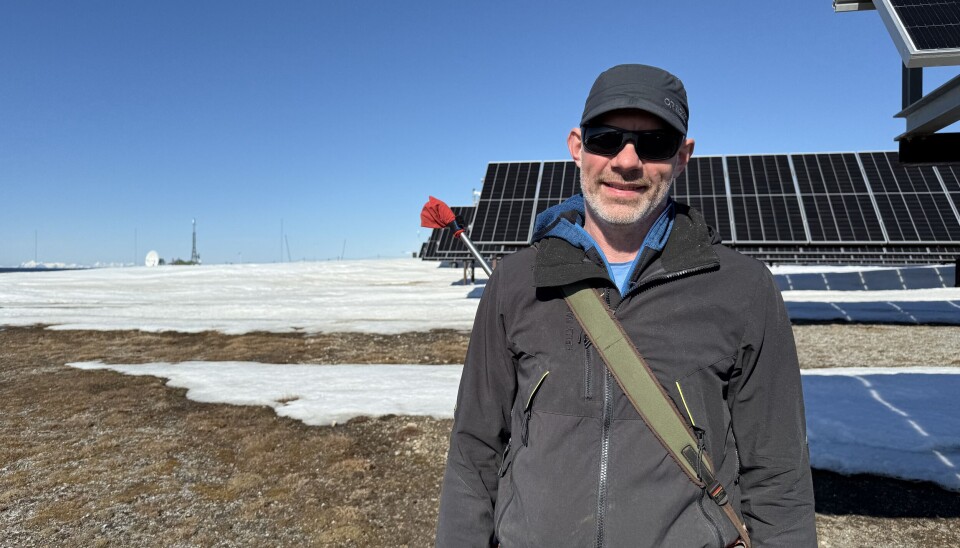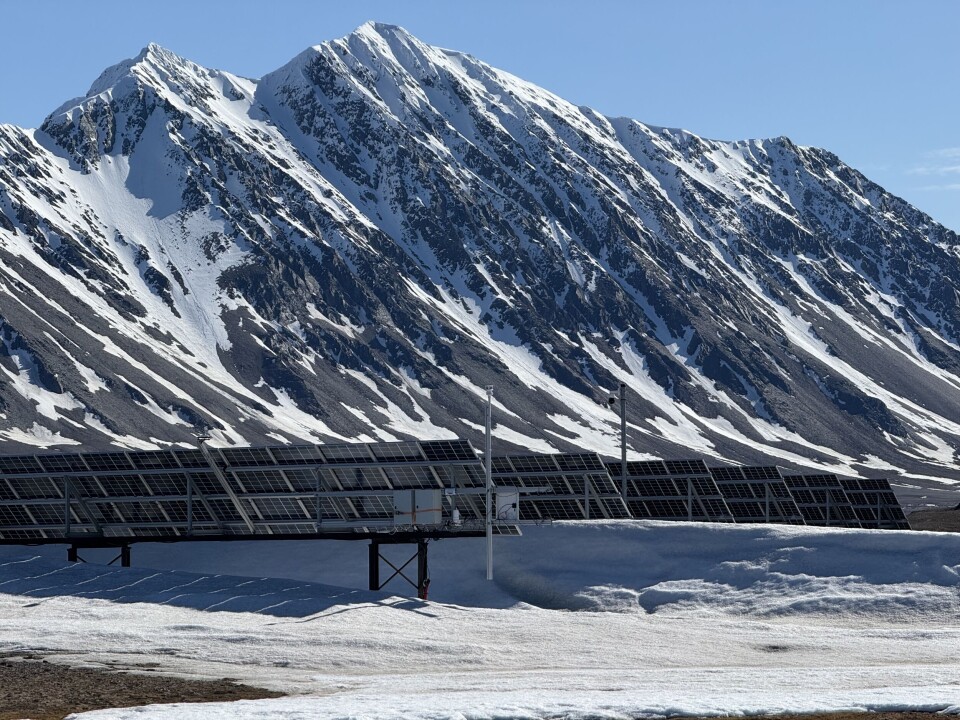
World’s northernmost solar park showcases zero-emission future for remote Arctic communities
Rifle and flare gun are mandatory when Inge Jørstad walks over the permafrost to the large solar park powering Basecamp Isfjord Radio. Here, polar bears are a bigger threat than technical breakdown. The facility is pioneering a renewable energy future for Svalbard as Norway's last coal mine shuts down on June 30.
May 17th this year came with double celebration at Isfjord Radio. Not only was it Norway’s National Day, it was also the first full 24-hours when solar panels produced all electricity demand for the adventure basecamp, some 50 km west of Longyearbyen on the coast to the Greenland Sea.
The park features bifacial modules which absorb light from the front and back. With white snow on the ground until early June, the light is reflected back to the underside cells and more power is produced. Also, the sun doesn’t set at Svalbard from late April until late August.
"Powering the buildings here with solar power is perfect as we close down mid-winter when the sun is under the horizon," explains Inge Jørstad, the station’s operation manager and handyman.
Isfjord Radio was established in 1933 to secure communications between the settlements at Svalbard, ships sailing the northern Barents Sea, and mainland Norway. All radio and mobile phone links are today remotely operated from Bodø and Longyearbyen and the buildings serve as probably the remotest located wilderness hotel anywhere in the circumpolar Arctic.
"More and more tourists are looking for destinations with green sustainable eco-solutions," Inge Jørstad tells as he shows us how the technical solutions work.
Whereas almost 200,000 lites of diesel fuel were burned in previous years to provide electricity and heat, the specially designed new autonomous energy installations prove that also the Arctic can be a frontrunner in global race for transition to renewables.
"We reduce the use of fossile fuel by 70%," Jørstad says.
When the solar panels produce more power than the Basecamp hotel consumes, the surplus is used to charge a battery bank. There are also 12 water tanks with a capacity of 12,000 litres in the basement of the main building which is used as a thermal storage. This water is then used to heat the buildings at night when the sun isn't as strong as during the day.
Six ground-mounted rows with a total of 360 bifacial panels - a 198 kW system - has an expected energy production of 161,000 kWh/year. Additional solar panels on the rooftops of three of the buildings have a installed capacity of 96 kW, estimated to produce 60,000 kWh/year.

When solar panels prove successful at 78°N, it can work anywhere in the circumpolar Arctic.
There are about 1500 settlements in the remote Arctic that are off-grid, not connected to a centralised electrical grid system. Most of them run on coal or diesel fuel.
Isfjord Radio serves as a unique pilot project that could pave the way for a much larger zero-emissions energy supply system for Longyearbyen.
Snow reflects sunlight off the ground and further enhances output, making it possible to produce energy on both sides.
With up to 70% of the energy generated from the sun, the hotel still has to burn diesel.
Next step on the wanted-list towards 100% renewable is a windmill. It would generate needed electricity in the darkest months of polar night. Or when fog and clouds make solar panels less efficient.
A wind mill, however, could come in conflict with the Kapp Linné birdlife protected area.
It is Store Norske Energi AS that runs the pilot solar energy system at Isfjord Radio. Being a daughter company of Store Norske, the corporation that for more than 100 years was in charge of coal mining at Svalbard, it today brands itself as a leader in transformation and development of clean energy systems for the remote Arctic.
On June 30, 2025, the last coal mine, Gruve 7, outside Longyearbyen shuts down. The day is a historic milestone for Norway. While coal mining has been the dominant industry for over a century, it is now transitioning towards tourism and research.
The coal power plant in town is already closed, temporarily replaced by diesel generators. From Oslo, the Norwegian government has in its Svalbard strategy made clear that the ambition is to have fossil fuels superseded with renewables by 2030.
That goal might prove difficult.
"It is wise to be cautious and not to overstate the replicability of the Isfjord Radio model for Longyearbyen," says associate professor Berit Kristoffersen with the Arctic Center for Sustainable Energy (ARC) at UiT The Arctic University of Norway.
She praises Store Norske for doing a great job at piloting an off-grid energy system at Isfjord Radio.
"While the Isfjord Radio pilot cannot be directly replicated in Longyearbyen due to differences in scale and demand, it serves as a crucial testing ground for renewable technologies such as solar power and potentially wind power in extreme conditions — knowledge that can inform and accelerate Longyearbyen’s own green transition," Berit Kristoffersen says.
She adds that Isfjord Radio operates seasonally, shutting down during the coldest and darkest winter months.
"Longyearbyen, on the other hand, requires continuous 24/7 operation through some of the harshest conditions on Earth."
About 2,600 people live in Longyearbyen, making it the world's northernmost settlement with a population greater than 1,000
While the direct replication of the Isfjord Radio system in Longyearbyen is neither feasible nor desirable, the lessons learned there are instrumental in shaping a more resilient, diversified, and sustainable energy future for Svalbard’s main settlement.
Kristoffersen's research colleague, Matteo Chiesa, adds: "Many of the technologies and strategies tested at Isfjord Radio do have clear transferability." He lists:
- Solar PV, despite its seasonal limitations, has demonstrated viability even at such high latitudes. This experience supports broader adoption in Longyearbyen, where summer production can offset significant amounts of fossil fuel use.
- Wind energy, if deployed with anti-icing solutions and appropriate turbine selection, could play a complementary role, especially in shoulder seasons and during winter darkness.
- Smart grid technologies, hybrid system controls, and energy storage solutions developed and refined at Isfjord Radio offer a blueprint for managing variability and ensuring system stability — a major challenge in remote Arctic communities.
Svalbard has in recent years become a high-end destination for international politicians and others on climate-crisis safari aiming to learn about impacts on the Arctic archipelago which is warming at triple the rate of the rest of the world.
By showcasing solutions, how to transform from a fossil-fuel dependent society to a zero-emission future, Longyearbyen brings hope to the table for coming generations.
Associate professor Berit Kristoffersen, however, believes it will take time for Svalbard to go green.
"A hybrid system that combines local renewables with cleaner fuels over time offers the most practical path forward — one that balances energy security, reliability, cost-effectiveness and climate and ecological considerations," she says.
"The most realistic scenario is probably that Longyearbyen´s energy system will be based on diesel generation until the generators will have to be replaced in 10-15 years or so, and phasing in local renewable energy production."
At Isfjord Radio, Inge Jørstad is thankful for what he learns from operating the solar powered energy system.
"For me personally, this brings real good competence. When not here, I work with regional authorities in Troms county [mainland northern Norway], and we have many remote located small societies where off-grid renewable systems could help us cut emissions," Jørstad says with enthusiasm.
Kristoffersen agrees:
"There are definitely lessons from Longyearbyen that could benefit others in the long run, especially within Northern Norway . Places in Troms and Finnmark face comparable issues with icing on wind turbines or snow-covered solar panels. So rather than thinking of Arctic settlements as isolated cases, we should see them as part of a broader network of cold-climate energy systems. What works in one place can often be adapted — with some modifications — to another."
































